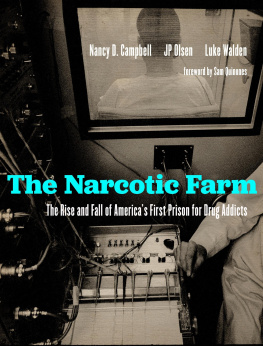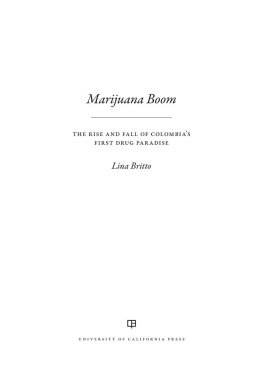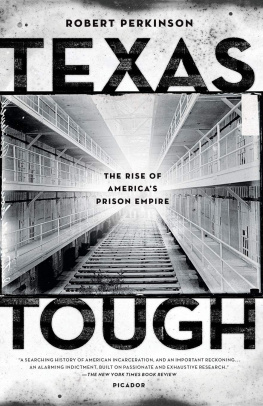The Narcotic Farm
The Narcotic Farm
Nancy D. Campbell
JP Olsen
Luke Walden
Contents
Foreword
When I was beginning research for my book about the opiate-addiction epidemic in America, I asked to visit the looming prison hospital north of Lexington, Kentucky. It was built during the 1930s New Deal and had once been a legendary place, a center for treatment and incarceration of drug addicts known as the Narcotics Farm.
The Farm had closed in the 1970s, and the building was converted into a hospital for the federal prison system. Because of its place in the history of American drug use and treatment, I thought it was worth a glimpse.
Sadly, officials there saw fit to deny my request. So instead, I took some time away from visiting in-laws in the Midwest, dipped down into Kentucky, and spent the snowy New Years Day of 2013 wandering around the facilitys perimeter, taking notes on the hulking building.
But the truth is I already had a pretty good idea of what it looked like inside because Id read an earlier edition of the book you hold in your hands. Id seen the photos of the vegetable gardens, the tennis courts, the jazz jam sessions, the nurses and doctors.
This book mesmerized me.
As youll see in these pages, the Farm, surrounded by rolling hills and horse properties, may have been the most integrated spot in the United States for several decades. Latinos, gays, blacks, whites, straights, Asiansheroin addicts allwere sent to the Narcotics Farm from across America. There, they grew food, wove baskets, and volunteered for experiments conducted by doctors studying the addictive qualities of one drug after another.
Ever since the Harrison Act, when as a country we shifted away from viewing drug addiction as a medical issue, drug addicts were being sent to prison for the first time in U.S. history. There, they had disrupted the order of life in custody that criminals set for themselves. Thus prison wardens from around America were happy to ship imprisoned addicts off to Lexington.
The Narcotics Farm existed for some forty years, until rather weird stuff began occurring in the 1970s.
Yet for all its mistakes, we might benefit from something like the Narcotics Farm these days. As I write, opiate addiction is just one facet of a generalized epidemic of addictiona backdrop of legal yet addictive social media apps, video games, gambling, pornography, and sugar.
All this highlights how common, ordinary really, addiction is among human beings, given the brains we possess. Our current state of affairs makes clear, too, that the world could use the kind of center for the study of addiction that the Farm evolved into.
Until that happens, I invite you to dig into this book and the story it tells, which is doubtless one of the strangest in the history of American drug use.
Sam Quinones Author of Dreamland: The True Tale of Americas Opiate Epidemic
Introduction
The Narcotic Farms goals were audacious: nothing less than the complete social rehabilitation of Americas drug addicts and the discovery of a permanent cure for drug addiction. Today this dual mission seems hopelessly naive. But for decades these hopes animated the federal governments quest to solve the problem of drug addiction by confining the nations addicts in one institution and transforming them into productive citizens.
From its opening in 1935, the Narcotic Farm epitomized the nations ambivalence about how to deal with drug addiction. On the one hand, it functioned as a compassionate and humane hospital where addicts could recover from their drug habits. On the other hand, it was an imposing prison built to incarcerate drug addicts. Conceived and run jointly by the Bureau of Prisons and the Public Health Service, the Narcotic Farmset on 1,000 acres of farmland just outside of Lexington, Kentuckywas an anomaly, an institution where male and female convicts arrested for drugs did time along with volunteers who checked themselves in for treatment. For both populationswhich lived and worked together regardless of their legal statusgoing to Lexington meant they were taking the cure.
Narco, as it was known locally, housed a coed cast of strange bedfellows: heroin-addicted jazz musicians, opiate-abusing MDs and nurses, street hustlers and prostitutes from New York, and Dilaudid-addicted drugstore cowboys from the rural South were all in the mix. Described in the press as everything from a New Deal for the Drug Addict to a million-dollar flophouse for junkies, the Narcotic Farm became a rite of passage for countless young addicts as well as the central gathering place for Americas growing drug subculture.
Next page



























